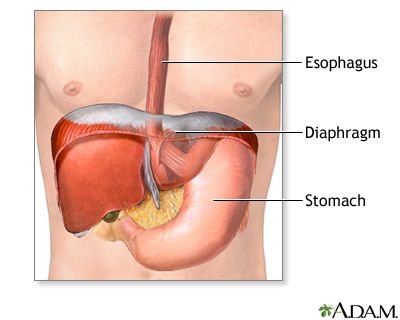by Marco Pasolini, Registered Osteopath D.O.
Osteopathy and especially the so-called Visceral Osteopathy are two important care solutions that Osteopaths can use to treat and reduce the heartburn (Gastroesophageal Reflux)

Gastroesophageal Reflux Disease (GERD) is the most prevalent disease of our "gut" which is estimated to affect a large scale between the UK population.
For better understanding it is important to know what GERD is, implicated anatomical hints and what can be modified through an Osteopathic approach. Food (bolus) passes through the esophagus then into the stomach, between these two structures there is a valve called lower esophageal sphincter or cardias. This valve is very important (controller) for passing food and not let food back up causing an increasing in gastric acid juices produced. The esophagus is not well protected from high acidity level which might lead to irritation and burn-like feeling.
First of all, burning pain (pyrosis) located behind the chest bone, nausea, belching, regurgitation, bloating, bad breath and headache. Stomach pain aggravated by some certain movements like bending forward or lying down (in fact many people prefer tummy position during night sleeping or whether very severe, sitting position is the only position they get relief from). Pain increases by coughing, expiration or recurrent hiccup.
It’s also caused or made worse by: Coffee, Alcohol, chocolate, fatty or spicy food; being overweight, smoking, stress and anxiety, some painkillers.
Sometimes serious damages can occur to the oral mucosa (inner layer of an organ) or teeth, called erosive Reflux (ERD) or non-erosive (NERD) which require a medical approach.
The importance of having a early diagnosis or detecting what triggers this problem by a Doctor specialist (Gastroenterologist) is the key. However, sometimes it's not that simple to diagnose GERD which might cause anxiety and fear to the patient experiencing chest pain.
The capacity of the cardias to work properly depends on various reasons: some tissues type, the muscle tone or relating to mechanical restrictions (here we can treat successfully)
In order to have a good stomach’s functionality there must be an equal pressure between thoracic cavity (chest) and abdominal cavity (tummy); the stomach may otherwise be pulled upwards (with risks to create Hiatal hernias) or downwards (with risks to prolapse).
There’s to be a good flexibility of the diaphragm muscle and its attachment to the spine along with a fascial restriction-free esophageal tract as well as a good relationship between thoracic spine and chest.
Osteopathy gives us the right tools to loosen up the body frame, diaphragms and re-balance the entire structure. Following our Osteopathic Philosophy, we are going to treat the neck for some neurological implication with the diaphragm and giving the correct stimulation to the neurovegetative system through those spinal tracts related to. The osteopath might carry out specific manipulation to release joints related directly or indirectly to the affected part. To dial with GERD the patient can get through a proper exercises program, yoga and meditation whereas muscle tensions and stress level are part of the disorders.
Addressing Gastroesophageal reflux with Visceral Osteopathy could be a reasoneable solution for a complete treatment of GERD.